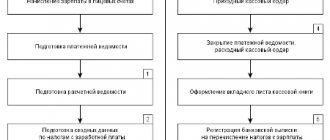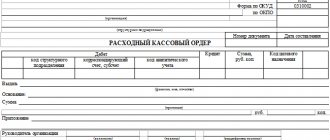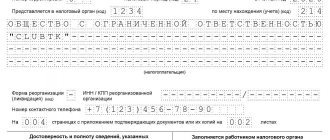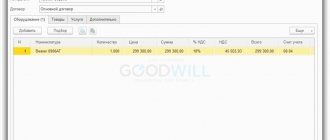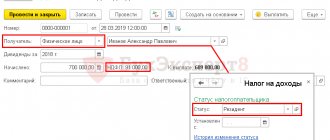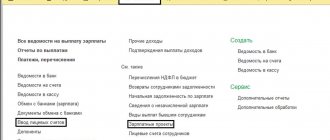Who is affected by the changes in the procedure for conducting cash transactions?
To one degree or another, innovations in the procedure for conducting cash transactions affected all business entities. In particular:
- individual entrepreneurs and organizations that are small businesses (you will find the criteria for small businesses in this article);
- organizations that are not small;
- organizations with separate divisions;
- persons using cash registers or strict reporting forms (read more about accounting for funds when using online cash registers here);
- employers giving money to employees on account.
Let us now consider these changes in more detail.
How is the cash balance limit set for certain categories of business entities?
As can be seen from the formulas, the company needs to carry out activities for some time in order to calculate the cash balance limit. What should newly created organizations do? For them, Directive 3210-U provides for the establishment of a limit based on estimated, rather than actual, volumes of receipts or issues.
Source:
People's Advisor
Heading:
Cash transactions
cash balance limit cash register cash transactions
- Bela Trombach, expert in accounting, taxation, budgetary accounting
Sign up 8645
12350 ₽
–30%
Conducting cash transactions: comparison of current and old rules
For clarity, we will present the main changes in the procedure for conducting cash transactions in the form of a table (comparison of current and previous rules, including taking into account those introduced by Directive No. 5587-U, effective from November 2021, and No. 4416-U of 2021).
| Operations affected by changes | Changes in the procedure for conducting cash transactions from November 30, 2020 | The procedure for conducting cash transactions, in force since 2017 |
| Issuance of money on account | The calculation rules have not changed except for the following aspects:
| To issue cash to an employee on account for expenses associated with the activities of a legal entity or individual entrepreneur, an expense cash order is drawn up in accordance with a written application of the accountable person, drawn up in any form, or an administrative document of the manager. The application or administrative document must contain a record of the amount of cash and the period for which it is issued, as well as the manager’s signature and date. If an application is drawn up for accountable amounts, then the manager is not required to indicate the amount of accountable funds and the period. The accountable himself can do this. And the manager will only sign and date it. Issuance on account is allowed if the recipient has not reported on the previous advance. |
| Interaction between the head office and department offices | Separate divisions have the right not to keep a cash book if they do not store funds, but hand them over to the cash desk of the parent organization. | An organization that has separate divisions (SU) has the right to independently establish the procedure and timing for transferring to the parent organization copies of the SE's cash book sheets, taking into account the deadline for drawing up accounting (financial) statements (clause 4.6 of Directive No. 3210-U). |
| Requirements for working with automatic devices for accepting and issuing money without the participation of employees (vending machines) have been approved. | The name of software and hardware has been changed to automatic devices for receiving and squeezing money without the participation of workers. They must automatically accept and issue banknotes and be able to recognize at least 4 machine-readable security features over the entire area of the banknote given in paragraph. 14–19 clause 1.1 of the Central Bank Regulations dated January 29, 2018 No. 630-P. | Software and hardware must be “able” to recognize banknotes based on 4 security features established by the regulations of the Central Bank. |
| New rules for accepting and issuing banknotes | When accepting banknotes, the cashier is required to check their solvency. At the same time, he is obliged to accept banknotes that do not contain signs of counterfeiting, are without damage or have abrasions, extraneous inscriptions, punctures, missing corners or edges and other minor damage. The cashier is prohibited from issuing banknotes that have one or more damages such as extraneous inscriptions of 2 or more characters, violation of the integrity of the banknote, a lost corner (more than 32 sq. mm) or a torn edge (7 mm or more in length), as well as other damage , specified in paragraph. 6–15 clause 2.9 of the Central Bank Regulations No. 630-P. Such banknotes should be handed over to the bank. | — |
| Identification of the recipient of funds | The cashier must ensure that cash is issued to the person indicated in the cash receipt order. Request for document verification. identification is excluded. | When issuing funds, the cashier is required to check the identity document. |
| Salary deposit | The rule about reflecting in the payroll the deposit of wages not paid on time is excluded. | On the last day of issuing cash intended for payment of wages, the cashier in the payroll record makes an entry “deposited” opposite the names and initials of employees who have not been issued cash, calculates and writes in the final line the amount of cash actually issued and the amount subject to deposit. |
For other innovations, see the ConsultantPlus Review and receive free demo access to the K+ system.
ConsultantPlus experts described a step-by-step algorithm for conducting cash transactions and maintaining cash discipline. Get free demo access to K+ and go to the Ready Solution to find out all the details of this procedure.
In addition to Instructions No. 3210-U, businessmen must comply with Instructions No. 3073-U dated 10/07/2013. According to this document, firms and individual entrepreneurs have the right to spend cash received for goods (work, services) sold exclusively for payment:
- employee salaries;
- insurance compensations under insurance contracts;
- remuneration for work/services, as well as for payment for goods (within 100 thousand rubles under one contract);
- accountable funds;
- for personal needs of individual entrepreneurs not related to entrepreneurship;
- returns for goods (work/services).
Individual entrepreneurs can use a simplified method of conducting cash transactions. If you have access to ConsultantPlus, check whether you are accounting for the entrepreneur’s funds correctly. If you do not have access, get free trial access to the system and proceed to the Ready-made solution.
Let’s combine the requirements of the Central Bank Directives into a convenient scheme:
LiveInternetLiveInternet
There are things in the world that cannot be described by simple logic. However, all those who want to change their lives for the better should know about them. You should always remember that signs tend to come true, regardless of whether you believe in them or completely refute them.
Of course, special attention should be paid to money signs. Then you will be able to improve your financial situation.
Let's figure out together what needs to be done to make your savings multiply. Be sure to take note of a few rules.
Rule one
If you repaid a debt, received a salary or an advance, took out a loan - take everything you received to your home. Don't part with your money on the first day. If you were going to buy something with them, take the required amount from your stash or pay by card, but the bills you just received should stay in the house at least overnight to charge your aura with monetary energy. You need to hide them in a secret place, preferably where you hide all your precious things.
Rule two
Banknotes must be stored in a wallet, facing you. Some practitioners recommend folding bills so that when you open your wallet, all the big money is located closer to you. They should not be folded, bent, crumpled, torn, placed upside down or moved from place to place. The choice of wallet should also be taken responsibly, because it is with the help of it that you exchange energy with your money. To attract money, the wallet must be new and expensive, not cheap and shabby. By buying a wallet, you determine your financial luck.
Rule three
Absolutely every person has their own lucky number, banknote or coin. This can work to your advantage if you use your favorite thing or number to make a real money talisman for yourself. The amulet will attract additional financial flows to you, which will increase your income. You need to store such a thing directly next to the money, periodically taking it out to update or cleanse the energy.
Rule four
There is a belief about a unique money talisman. It is a bill with a number that corresponds to two, three or, ideally, four numbers of your year of birth. Such an amulet cannot be searched for or exchanged: according to legend, it must find you on its own. Therefore, carefully monitor all bills that pass through your hands. If your talisman finds you, keep it, do not give it to anyone and do not waste it - this is your guide to the world of stability, success and prosperity.
Rule five. It is prohibited to put money in bundles, especially those with an odd number of banknotes. According to an old belief, such money will quarrel and abandon you. Each money must have its own pair. Keeping money in fifty pieces is also prohibited. “Five tens is a disadvantage,” our great-great-grandfathers knew about this.
Rule six
The element of money is earth and metal, therefore, the more your money interacts with its energy sources, the more it becomes. Some esotericists advise storing money at the bottom of a pot of earth, others - tying it with a metal thread, and still others - purchasing a special gold or silver holder for banknotes.
Rule seven
If you want to increase your income, you need to perform one simple ritual for money. We will turn to numerology, which is closely related to the energy of money and prosperity. Write the following formula on a piece of paper: “7+1=8”, where 7 is the personification of the energy of action, 8 is a symbol of infinity, and 1 is a sign of stability.
Source: https://mistika.temaretik.com/1597201581766085220/…i-chtoby-ih-stanovilos-bolshe/
Responsibility for violation of the rules for conducting cash transactions
And in conclusion, a few words about responsibility. For violation of the procedure for working with cash and the procedure for conducting cash transactions, administrative liability is provided under Art. 15.1 Code of Administrative Offenses of the Russian Federation. This is a fine: for officials - from 4 thousand to 5 thousand rubles, for legal entities - from 40 thousand to 50 thousand rubles.
In this case, violations include:
- making cash settlements with other organizations in excess of established limits;
- non-receipt (incomplete receipt) of cash to the cash desk;
- failure to comply with the procedure for storing available funds;
- accumulation of cash in the cash register in excess of established limits.
Read more about liability for violation of the procedure for conducting cash transactions in the article “Cash discipline and responsibility for its violation .
Electronic cash orders
It is allowed to keep track of the movement of valuables at the cash desk of an enterprise using electronic orders, but for this the cashier must have a qualified electronic signature. Having accepted the money, the cashier may not print out the cash receipt order, but send a receipt to the PKO, signed with a digital signature, to the depositor’s email.
The expenditure order (RKO) does not need to be printed if it is signed by two digital signatures - the cashier and the cash recipient.
Results
There are no plans to make any changes to the procedure for conducting cash transactions in 2021. The 2021 amended rules, effective as of 11/30/2020, continue to apply. Some of the innovations affected the procedure for working with accountants. Other changes were related to the separation and handling of damaged banknotes.
You can find more complete information on the topic in ConsultantPlus. Free trial access to the system for 2 days.
How much do online cash registers cost?
The main disadvantage of online cash registers is their high cost.
The cost of installing new equipment will not be limited to purchase costs. In addition, you will have to regularly pay the fiscal data operator for processing and sending it to the tax office, and also invest in ensuring uninterrupted Internet access, otherwise the cash desk will not be able to send checks. The cheapest option is autonomous cash registers: 12–20 thousand rubles. Fiscal registrars are more expensive, 15–40 thousand rubles. The most expensive monoblocks, their prices can vary greatly depending on the functions.
However, when choosing an online cash register, you should not be guided by price, but based on the specifics of your business: the cash register must correspond to its volume, meet legal requirements and not contain functions unnecessary for your company.
Fold bills from left to right.
Traditionally, it is correct to fold banknotes at the cash register from left to right in ascending denomination: 10, 50, 100, 200, 500, 1000, 2000 and 5000 rubles. This sequence is convenient for right-handers: control over the right hand is greater and at the subconscious level the cashier has better control over large denomination bills.
Usually the cash register is located so that “small” money is closer to the client than large ones, which reduces the temptation to take advantage of the fact that the cashier is distracted. There are other features of the placement of banknotes:
- There is no longer a cell allocated for the 10-ruble banknote - there are few of them left in circulation, so they are simply placed on top of the 50-ruble bills in the first cell and, if possible, given back in change.
- In small cash registers, where there are only 4 slots for banknotes, the most popular denomination is chosen. Most often, such cash registers are used in small convenience stores, so banknotes of 50,100, 200 and 500 rubles are left in the cells, and the rest are removed.
- With a mirror arrangement of the cash register, when the right side with large money is located closer to the client, it is better to place banknotes in the cash register from right to left.
- At cash registers with vertical cells, bills are sorted in ascending order from bottom to top, from the cashier. Such cash registers are convenient because large denomination banknotes are hidden in the cash register, and money is at hand for payment.
How to maintain a cash book in 2021
Fill out the cash book only for those days when you received or issued cash. The basis for the entries will be incoming and outgoing cash orders. If you do not make entries, the inspectorate will fine you during the inspection (Clause 1, Article 15.1 of the Administrative Code):
- company - in the amount of 40,000 to 50,000 rubles;
- entrepreneur or director of a company - in the amount of 4,000 to 5,000 rubles.
The procedure for conducting cash transactions in 2021 provides that the cash book can be maintained in several ways:
- by hand on paper;
- fill out on the computer and then print;
- electronic.
Entrepreneurs who keep records of income and expenses or physical indicators in accordance with tax legislation have the right not to fill out a cash book (clauses 1 and 4.6 of Directive No. 3210-U). Individual entrepreneurs who have not refused to register cash transactions maintain one cash book.
For companies, the number of books depends on whether they have separate divisions. If not, companies keep the same book regardless of whether they have combined tax regimes. If there are separate divisions, then keep your own cash book for each division (paragraph 7, clause 4.6 of Directive No. 3210-U and letter of the Federal Tax Service dated May 17, 2013 No. AS-4-2 / [email protected] ).
Issuance of wages according to statements
If it is customary for an organization to pay wages according to a statement, then you need to select one of two statements that are available by clicking the “Print”
:
“Payroll”
in form T-49 and
“Payroll”
in form T-53.
In the unpaid document “Statement to the Bank”
in the lower left corner under the tabular part there is a button
“Pay statement”
.
When you click on this button, a “Cash Withdrawal”
:
with the type of operation “Payment of wages according to statements”
:
The printed form of the document is represented by “Cash receipt order”
according to the KO-2 form. Before creating an order, you must fill in its details:
As a result of posting the document, transactions will be generated, an example of which is shown in the figure below:
Document “Statement to the cash desk”
To pay wages in cash, we will use the document “Statement to the Cashier”
.
Access to the document in the Salaries and Personnel section - Salaries
:
When filling out the header of the document, select the type of payment: advance or salary. After filling out the required fields in the document header, the tabular part can be filled out automatically by clicking the “Fill”
:
Only those employees for whom it is indicated that they receive a salary in cash will be entered in the tabular part of the document.
Please note that in the “Payment”
When the statement is automatically filled in for salary payment, the amount to be paid will be indicated, taking into account the previously paid advance.
In the “NDFL”
The link that opens when you click on the total personal income tax amount will show the calculated tax amounts in a breakdown:
To post the document, use the “Post”
in the header of the document.
